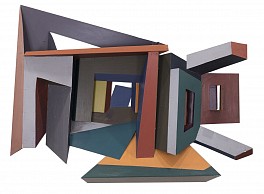BIOGRAPHY

Canadian-American, 1928-2011
Sylvia Stone was a well-known constructivist-minimalist sculptor. Born in Canada in impoverished circumstances, she came to the US in 1946 at age 17 to study at the Art Students League. She began with painting. Preference was given returning soldiers, so Stone would often sneak into classes in order to receive some criticism of her painting,
then work at home.
She married the abstract painter and Chairman of Yale University's School of Art and Architecture, Al Held, at a young age. Stone herself would go on to became a Professor of Art at Brooklyn College, New York.
By the 1960s, with the art world's increased awareness of materials and their manipulation, she abandoned hard-edge abstraction and began to work with Plexiglas and metal (aluminum) as her medium. These works may be viewed on one level as reflecting the artist's inbuilt need to construct a home, a place where her spirit may express itself and find residence.
One critic described her work this way:
Sylvia Stone’s reliefs made me “turn upon myself” and look again. At first they appear cooly aware, smart in the sense of stylish. Made of plexiglass planes and bits of metal, they are lean and elusive—reliefs that know how to look . . . like “the latest” in reliefs. They know how to talk, too: they refer to Stella’s relief “paintings,” cite Morris’ mirror works, and converse generally on Constructivist relief. That is, Stone makes the important references at a glance (as far as pedigree and peers go) but summarizes, paraphrases—reviewing, rather than revising. I thought Stone recouped relief (a very recalcitrant form), by making it slick and easy to consume.
In 1975, she was part of the major show at the Whitney Museum of American Art, New York City, "Two Hundred Years of American Sculpture." She was represented by Tibor de Nagy and Andre Ammerich.
Sylvia Stone's sculpture is in the collections of the Whitney Museum of American Art; Wadsworth Athenaeum, Hartford, Connecticut; Aldrich Museum of Contemporary Art, Ridgefield, Connecticut; and Walker Art Center.
